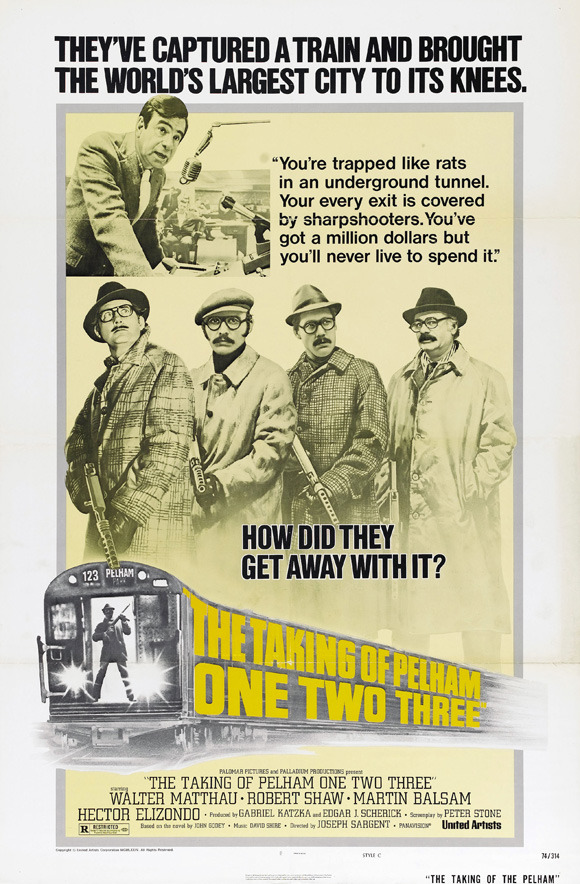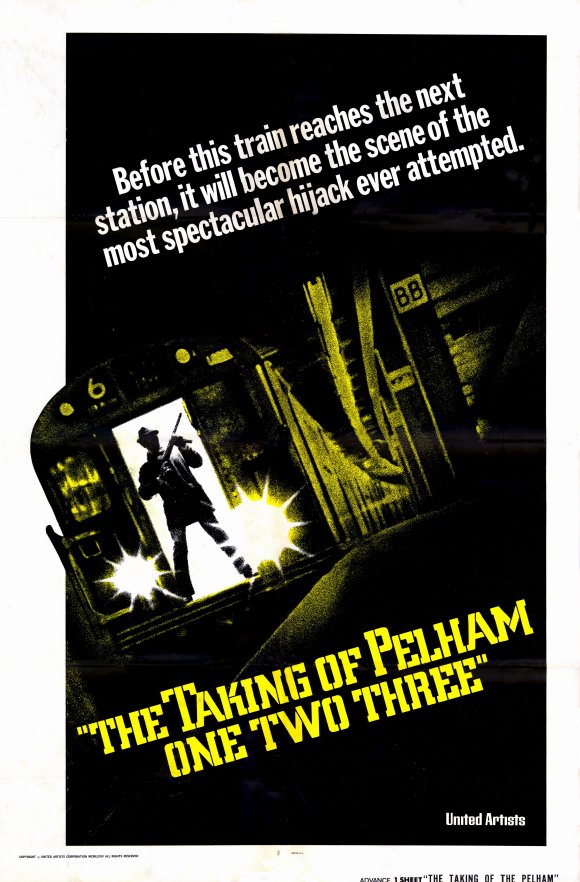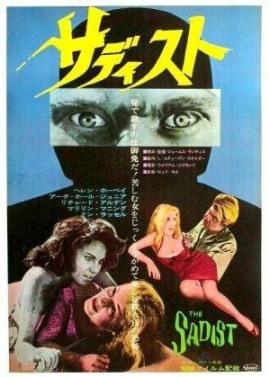Usually when movies make that claim they are either half right (Texas Chainsaw Massacre [1974], which found inspiration in the real life killer Ed Gein) or just completely made up (as is with Fargo [1996]), but in the case of The Town that Dreaded Sundown, it truly was based on an actual series of murders that took place in 1946, with only the names of those involved and some of the details changed. The movie is a decent piece of drive-in fare, albeit one with more than its share of problems, namely some wild tonal shifts into comedy and the piss-poor lighting and night photography. The Town that Dreaded Sundown is far from a great movie, but it has a good idea and a memorable and iconic screen villain in "The Phantom Killer."
The Town that Dreaded Sundown has a basic story and premise, one that is not unlike the slasher films that would become popular half a decade after its release. A mysterious and masked killer is randomly attacking the people of the Texarkana community, usually couples out in remote areas. The local law enforcement, led by Deputy Ramsey (Andrew Prine), struggles to crack the case, and as panic grows, Texas Ranger Captain Morales (Ben Johnson) joins the hunt. Part of the movie plays like a police procedural, as the authorities field phone calls from concerned citizens and deal with local nutcases coming in and making wild claims.
The movie is also presented in a docudrama style, with a narrator that introduces the film and occasionally pops back in to fill the audience in on backstory and other facts in the case. In addition to that, the calendar dates of the murders flash on screen and, along with the narrator, this gives the film (which is otherwise shot like an ordinary horror film) a feeling or look of a television true-life mystery program, like an Unsolved Mysteries but with better reenactments. (note: I thought that Unsolved Mysteries analogy was an original thought, but turns out that comparison is mentioned on the film's wikipedia page. Sigh. . .so much for original thoughts...)
In 1946, during a ten week span between February and May, eight people were attacked, five of which were killed, in the small town of Texarkana. The attacks took place late at night and on weekends and were usually three weeks apart. They took place mostly in the remote surrounding areas on both sides of the Texas and Arkansas border. The Phantom Killer, as he became known, shot all his victims to death using a pistol. The crimes became known as the Texarkana Moonlight Murders and despite the efforts of local and state law enforcement, the case has never been solved.
The movie differs from those true-life events in changing some of the dates of the murders and some of the details, making the stalking scenes and the sadisticness of the crimes that much more frighteningly cinematic. The real Phantom Killer did indeed wear a white bag on his head with eye holes cut out, which is why the survivors of his first attack could not identify him. It is quite the creepy look, one that Jason Vorhees would borrow in Friday the 13th Part 2 (1981).
In the actual murders, the killer used a gun exclusively, with minimal bludgeoning and perversion, although psychiatrists did theorize that he was a sex deviant. The movie version of The Phantom is said to have "bitten and clawed" one victim like an animal, although that is done off-screen. Also, there is no evidence that the real Phantom Killer ever used a trombone to kill anyone.
This should be explained as it is easily the weirdest thing in the movie, which also makes it one of the most memorable things. Normally I would consider this a SPOILER but I can't not bring it up and mention it, it's just such an out-of-left-field moment. On the night of the High School Prom, a young couple, Roy and Peggy, head out to their favorite make-out spot, despite their better judgement and the fact that the town is on high alert at this time. After making out, the two of them fall asleep in the car, only waking up much later at night. When Roy tries to leave, the Phantom suddenly leaps onto their car and pulls Roy from the vehicle. After whacking Roy in a head with his pistol, the Phantom chases down Peggy in an extended chase scene and after catching her, he ties her to a tree. When Roy tries to escape, the Phantom shoots him dead. The killer then goes to the car, gets Peggy's trombone case, and proceeds to tie a knife to the end of the trombone slide. He then "plays" the instrument, stabbing Peggy to death. It's quite the fucked up scene, not only because of the absurd use of a brass instrument, but also for the brutal length and duration of the chase and stalking.
In general, the stalk and kill scenes are pretty good. They're lengthy, with a good amount of time devoted to tension build-up. Even when not onscreen, The Phantom's presence haunts the film. When he does pop up out of nowhere and attacks, it is genuinely freaky and disturbing, maybe none more-so than when The Phantom breaks into Helen Reed's (Dawn Wells) house and assaults her.
The Town that Dreaded Sundown is a cheap drive-in exploitation movie and it does on occasion fully display its cheapness. The night photography, especially during the first two attacks, is extremely dark and murky. After discovering a pair of victims, Deputy Ramsey chases The Phantom through the woods during a rainstorm and it is near impossible to see anything that is going on. The lighting is better for some of the later scenes, but is still wildly inconsistent.
Also inconsistent is the tone of the movie. In multiple scenes, the film dips into a broad territory of comedy, most of it delivered by hapless doofus Police Patrolman Benson, who is tellingly nicknamed "Spark Plug." At one point, Spark Plug dresses as a woman (as part of an attempted trap to lure The Phantom) and at another point he drives a car into a lake. It really is eye-rollingly bad, and not made any better by the fact that Patrolman Benson is played by director Charles B. Pierce. The swing from brutality to broad comedy leads me to compare the film to The Last House on the Left (1971), although the hayseed comedy of The Town that Dreaded Sundown is much worse and it never reaches the levels of vile sadisticness of Wes Craven's shocker.
Since this is based on a true story, the pseudo-documentary style adds to the unsettling nature of the film. Director Charles B. Pierce, who definitely brings a regional flair to his films, had experimented with this format before with his first feature film The Legend of Boggy Creek (1972), in which local townsfolk recount their encounters with the titular Bigfoot-like creature, complete with reenactments of said encounters. Pierce would go on to direct the western Grayeagle (1977), the viking film The Norseman (1978), the home invasion thriller The Evictors (1979), and a sequel to his first film, Boggy Creek II: And the Legend Continues (1985), which is really really corny and was featured on the tenth season of Mystery Science Theater 3000.
Strangely, Charles B. Pierce was just a director/writer/producer/actor on the side, as his main occupation in Hollywood was Set Decorator. While funding his own little projects, he worked on such varied films as Pretty Maids All in a Row (1971), Coffy (1973), Scream Blacula Scream (1973), Dillinger (1973), Black Belt Jones (1974), The Outlaw Josey Wales (1976), and Carny (1980).
Screenwriter Earl E. Smith wrote many of Pierce's early movies. Pierce and Smith both have story credit on Clint Eastwood's Sudden Impact (1983), the fourth Dirty Harry movie.
There is a Sheriff character in the movie, but he seems to take a backseat to Andrew Prine's Deputy Ramsey. Prine brings a bit of that small-town Texas swagger to Ramsey, and he has a couple good scenes, particularly the one where he chases the killer through the woods, as well as the ending, where he and Captain Morales give The Phantom one final chase. Andrew Prine is one of those B-movie actors that I'm fond of; he also starred in Simon, King of the Witches (1971), The Centerfold Girls (1974), Grizzly (1976), and Eliminators (1986).
I'd have to say this is far from his best work, but Ben Johnson does what he can with Texas Ranger Captain Morales. Johnson had a long career as a stunt man in the 40s, (doubling for John Wayne and James Stewart), starred in westerns in the 50s, and in TV shows in the 60s, which is where he met Sam Peckinpah, whom he would work with on The Wild Bunch (1969), Junior Bonner (1972), and The Getaway (1972). Ben Johnson would also work with Peter Bogdanovich on The Last Picture Show (1971, for which he won an Oscar), John Milius on Dillinger (1973), Steven Spielberg on The Sugarland Express (1974), and a bunch of Canadians on Terror Train (1980). He would work with Charles B. Pierce again on Grayeagle (1977).
Dawn Wells, who played home invasion survivor Helen Reed, is famous for playing Mary Ann on TV's Gilligan's Island. Strangely, she also starred in Return to Boggy Creek (1977), which is more of a kids fantasy movie than a sequel to Charles B. Pierce's film (he was not involved whatsoever).
Composer Jaime Mendoza-Nava worked with Charles B. Pierce often and also scored that weird-ass movie Mausoleum (1983).
Stuntman Bud Davis, who plays The Phantom (pretty well, in my opinion), would go on to a successful career as a stunt coordinator on big Hollywood films like Forest Gump (1994) and Inglorious Basterds (2009).
The Town that Dreaded Sundown has a pretty good idea and premise. The pseudo-documentary construction makes the film unconventional and interesting and the sparseness of the story works in the film's favor, as does the ominous and creepy baghead that The Phantom wears. It's only in some of the narrative choices (i.e.: terrible comedy) and with some of the shoddy production values that the film falters. The film also gets points for having a non-ending (and handling it well), with no answers and no real resolution, as the killer is never caught.
In reality, the killer was never brought to justice and rumors abound as to what happened to him. Some claim he was arrested for an unrelated charge, while some believe he would pick up his murder spree years later in the San Francisco area as The Zodiac Killer. What truly happened to The Phantom Killer is anyone's guess, as at this point it seems as if the truth about this serial killer will remain a mystery.
The Town that Dreaded Sundown (at least the VHS transfer I watched) is very rough looking, with washed out colors and dark, murky lighting. The night scenes are frustratingly dark; it looks like they were shot in actual darkness; like night for night. Hopefully, Scream Factory's new HD BluRay/DVD combo release (decked out with bonus features, including a bonus movie: Pierce's The Evictors [!!]) goes a long way in correcting these problems (and from what I've read and seen, it does indeed).
The above screencap is from the version I watched. The below picture I found is from the same scene and is apparently from the new BluRay. Andrew Prine's face says it all.































































